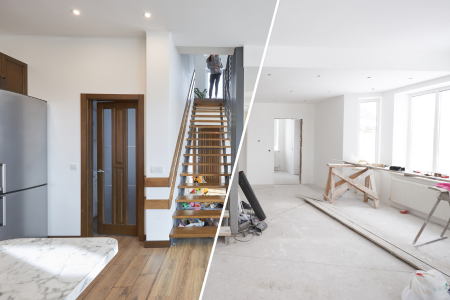You are not alone if you like the idea of flipping houses for a profit. Many people have chosen to enter the home-flipping world, often inspired by numerous HGTV shows. However, they typically find the business more challenging than expected, particularly when creating a budget.
Budgeting is among the most critical parts of a home flip. Without adequate finances to back your project, you could end up with a prolonged timeline or go bankrupt. Here are the most important considerations for a home-flipping budget, how to estimate a realistic cost, and ways to stay on track with spending.
Key Factors Impacting Home-Flipping Budget
Before investing in a home flip, it is essential to consider the project’s scope. On average, flippers spend between $19,517 and $87,511 on a broad-scale renovation in addition to the purchase price. However, this total cost could be significantly higher, reaching $185,000 or more.
Key factors you must consider for a successful home flip include the following:
- Design goals: Whether the project entails cosmetic or structural changes.
- Market: Competitive housing prices in the surrounding area help to determine the return on investment.
- Purchase costs: Whether there’s room for negotiation in the closing costs and purchase-to-renovation expense ratio.
- Renovation costs: Estimated costs for materials, labor, permitting, and inspections.
- Holding costs: Property taxes, mortgage interest, and utility fees.
Of course, flippers must also account for unexpected problems with the house. For instance, remediation for mold or asbestos could run $2,230 or up to $3,100, respectively, while cracks in the foundation could cost $2,200 to $7,700 to repair. It is critical to set aside extra cash for these unforeseen expenses.
How to Create a Realistic Budget for a Home Flip
Developing a realistic budget is among the more challenging aspects of a flip. Most experts recommend the 70% rule, stating you shouldn’t buy a flipper for more than 70% of what the property will likely sell for afterward, not factoring in repair costs.
Determining the overall potential expenses requires a detailed cost analysis for every room. You will want a professional contractor to walk through the house and contact suppliers for the most accurate quotes. This will also allow you to factor in contingencies and possible shortfalls.
Pricey renovations are sometimes unavoidable in a home flip, especially if you buy a foreclosed home, an auctioned house, or a property sight unseen. For instance, roof damage causes 70%-90% of home damage, meaning you can’t leave it in disarray, or you might not sell the house at the price you want.
Of course, the most effective way to create a budget is to finance the project through multiple sources. Banks, credit unions, and other financial establishments can provide loans for the project. Other options include taking out a home equity loan or home equity line of credit.
Maintaining a Home-Flipping Budget
Budgeting for a home flip requires careful planning. Once set, you will want to stick to it as closely as possible throughout the project. Pay close attention to your spending using a tracking software or spreadsheet to compare cost outputs to the budget. Flexibility is key, as the costs might go up or down.
There may be areas where you can save money without compromising quality, such as selecting more budget-friendly finishes like tile, hardwood floors, and cabinets. Contractors who use advanced tech-operated machinery can also ensure optimal equipment health and performance for consistent productivity.
When it comes to flipping houses, time is money — you are responsible for utilities, property taxes, homeowners’ insurance, and maintenance from the moment you close. Therefore, staying on track with your project timeline will allow you to list the house immediately and save in the long run.
On average, flipping houses takes four to six months from the purchase date, with additional time to sell. Naturally, the timeline is fluid based on how much work is involved and whether there are any setbacks with inspections, receiving materials, and installations. However, the longer it takes to complete, the more at risk you are of running out of money.
Budget Wisely for a Profitable Home Flip
Flipping houses is more expensive than it seems. Many first-time flippers experience sticker shock, wondering whether they made the right decision. Nevertheless, with a sufficient budget, you can profit from a newly renovated home and build your flipping business.

